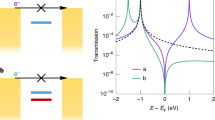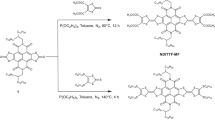Abstract
Research in molecular electronics often involves the demonstration of devices that are analogous to conventional semiconductor devices, such as transistors and diodes1, but it is also possible to perform experiments that have no parallels in conventional electronics. For example, by applying a mechanical force to a molecule bridged between two electrodes, a device known as a molecular junction, it is possible to exploit the interplay between the electrical and mechanical properties of the molecule to control charge transport through the junction2,3,4,5,6,7,8. 1,4′-Benzenedithiol is the most widely studied molecule in molecular electronics9,10,11,12,13,14,15,16,17,18, and it was shown recently that the molecular orbitals can be gated by an applied electric field11. Here, we report how the electromechanical properties of a 1,4′-benzenedithiol molecular junction change as the junction is stretched and compressed. Counterintuitively, the conductance increases by more than an order of magnitude during stretching, and then decreases again as the junction is compressed. Based on simultaneously recorded current–voltage and conductance–voltage characteristics, and inelastic electron tunnelling spectroscopy, we attribute this finding to a strain-induced shift of the highest occupied molecular orbital towards the Fermi level of the electrodes, leading to a resonant enhancement of the conductance. These results, which are in agreement with the predictions of theoretical models14,15,16,17,19,20, also clarify the origins of the long-standing discrepancy between the calculated and measured conductance values of 1,4′-benzenedithiol, which often differ by orders of magnitude21.
This is a preview of subscription content, access via your institution
Access options
Subscribe to this journal
Receive 12 print issues and online access
$259.00 per year
only $21.58 per issue
Buy this article
- Purchase on Springer Link
- Instant access to full article PDF
Prices may be subject to local taxes which are calculated during checkout




Similar content being viewed by others
References
Aviram, A. & Ratner, M. Molecular rectifiers. Chem. Phys. Lett. 29, 277–283 (1974).
Joachim, C., Gimzewski, J. K. & Aviram, A. Electronics using hybrid-molecular and mono-molecular devices. Nature 408, 541–548 (2000).
Xu, Bingqian et al. Electromechanical and conductance switching properties of single oligothiophene molecules. Nano Lett. 5, 1491–1495 (2005).
Parks, J. J. et al. Mechanical control of spin states in spin-1 molecules and the underscreened Kondo effect. Science 328, 1370–1373 (2010).
Meisner, J. S. et al. A single-molecule potentiometer. Nano Lett. 11, 1575–1579 (2011).
Quek, S. Y. et al. Mechanically controlled binary conductance switching of a single-molecule junction. Nature Nanotech. 4, 230–234 (2009).
Diez-Perez, I. et al. Controlling single molecule conductance through lateral coupling of π-orbitals. Nature Nanotech. 6, 226–231 (2011).
Kim, Y. et al. Conductance and vibrational states of single-molecule junctions controlled by mechanical stretching and material variation. Phys. Rev. Lett. 106, 196804 (2011).
Xiao, X. Y., Xu, B. Q & Tao, N. J. Measurement of single molecule conductance: benzenedithiol and benzenedimethanethiol. Nano Lett. 4, 267–271 (2004).
Reed, M. A. et al. Conductance of a molecular junction. Science 278, 252–254 (1997).
Song, H. et al. Observation of molecular orbital gating. Nature 462, 1039–1043 (2009).
Tsutsui, M., Teramae, Y., Kurokawa, S. & Sakai, A. High-conductance states of single benzenedithiol molecules. Appl. Phys. Lett. 89, 163111 (2006).
Taniguchi, M., Tsutsui, M., Yokota, K. & Kawai, T. Inelastic electron tunneling spectroscopy of single-molecule junctions using a mechanically controllable break junction. Nanotechnology 20, 434008 (2009).
Romaner, L. et al. Stretching and breaking of a molecular junction. Small 2, 1468–1475 (2006).
Ke, S. H., Baranger, H. U. & Yang, W. T. Contact atomic structure and electron transport through molecules. J. Chem. Phys. 122, 074704 (2005).
Li, Z. & Kosov, D. S. Nature of well-defined conductance of amine-anchored molecular junctions: density functional calculations. Phys. Rev. B 76, 035415 (2007).
Xue, Y. & Ratner, M. A. Microscopic study of electrical transport through individual molecules with metallic contacts. II. Effect of the interface structure. Phys. Rev. B. 68, 115406 (2003).
Kim, Y. et al. Benzenedithiol: a broad-range single-channel molecular conductor. Nano Lett. 11, 3734–3738 (2011).
Toher, C. & Sanvito, S. Efficient atomic self-interaction correction scheme for nonequilibrium quantum transport. Phys. Rev. Lett. 99, 056801 (2007).
Pontes, R. B. et al. Ab initio calculations of structural evolution and conductance of benzene-1,4-dithiol on gold leads. ACS Nano 5, 795–804 (2011).
Lindsay, S. M. & Ratner, M. A. Molecular transport junctions: clearing mists. Adv. Mater. 19, 23–31 (2007).
Xu, B. Q. & Tao, N. J. Measurement of single molecule conductance by repeated formation of molecular junctions. Science 301, 1221–1223 (2003).
Smit, R. H. M. et al. Measurement of the conductance of a hydrogen molecule. Nature 419, 906–909 (2002).
Hihath, J. & Tao, N. J. Rapid measurement of single-molecule conductance. Nanotechnology 19, 265204 (2008).
Haiss, W. et al. Precision control of single-molecule electrical junctions. Nature Mater. 5, 995–1002 (2006).
Zhou, J. F. & Xu, B. Q. Determining contact potential barrier effects on electronic transport in single molecular junctions. Appl. Phys. Lett. 99, 042104 (2011).
Sergueev, N., Tsetseris, L., Varga, K. & Pantelides, S. Configuration and conductance evolution of benzene–dithiol molecular junctions under elongation. Phys. Rev. B 82, 073106 (2010).
Hihath, J., Bruot, C. & Tao, N. J. Electron–phonon interactions in single octanedithiol molecular junctions. ACS Nano 4, 3823–3830 (2010).
Luo, Y., Lin, L. L. & Wang, C. K. Inelastic electron tunneling spectroscopy of gold–benzenedithiol–gold junctions: accurate determination of molecular conformation. ACS Nano 5, 2257–2263 (2011).
Chen, Y. C., Zwolak, M. & Di Ventra, M. Inelastic current–voltage characteristics of atomic and molecular junctions. Nano Lett. 4, 1709–1712 (2004).
Agrait, N., Untiedt, C., Rubio-Bollinger, G. & Vieira, S. Onset of energy dissipation in ballistic atomic wires. Phys. Rev. Lett. 88, 216803 (2002).
Arroyo, C. R. et al. Characterization of single-molecule pentanedithiol junctions by inelastic electron tunneling spectroscopy and first-principles calculations. Phys. Rev. B 81, 075405 (2010).
Kamenetska, M. et al. Formation and evolution of single-molecule junctions. Phys. Rev. Lett. 102, 126803 (2009).
Taniguchi, M., Tsutsui, M., Yokota, K. & Kawai, T. Mechanically-controllable single molecule switch based on configuration specific electrical conductivity of metal–molecule–metal junctions. Chem. Sci. 1, 247–253 (2010).
Okabayashi, N., Konda, Y. & Komeda, T. Inelastic electron tunneling spectroscopy of an alkanethiol self-assembled monolayer using scanning tunneling microscopy. Phys. Rev. Lett. 100, 217801 (2008).
Galperin, M., Ratner, M. A. & Nitzan, A. Inelastic electron tunneling spectroscopy in molecular junctions: peaks and dips. J. Chem. Phys. 121, 11965–11979 (2004).
Paulsson, M. et al. Unified description of inelastic propensity rules for electron transport through nanoscale junctions. Phys. Rev. Lett. 100, 226604 (2008).
Beebe, J. M., Kim, B., Frisbie, C. D. & Kushmerick, J. G. Measuring relative barrier heights in molecular electronic junctions with transition voltage spectroscopy. ACS Nano 2, 827–832 (2008).
Huisman, E. H., Guedon, C. M., van Wees, B. J. & van der Molen, S. J. Interpretation of transition voltage spectroscopy. Nano Lett. 9, 3909–3913 (2009).
Trouwborst, M. L. et al. Transition voltage spectroscopy and the nature of vacuum tunneling. Nano Lett. 11, 614–617 (2011).
Acknowledgements
This work was supported by the Basic Energy Science programme of the Department of Energy (DE-FG03-01ER45943, C.B.) and the National Science Foundation (CHE-1105588 and ECS-0925498, J.H. and N.J.T.).
Author information
Authors and Affiliations
Contributions
N.J.T. conceived the experiment. C.B. and J.H. performed the experiment and analysed the data. C.B., J.H. and N.J.T. co-wrote the paper.
Corresponding author
Ethics declarations
Competing interests
The authors declare no competing financial interests.
Supplementary information
Supplementary information
Supplementary information (PDF 1745 kb)
Rights and permissions
About this article
Cite this article
Bruot, C., Hihath, J. & Tao, N. Mechanically controlled molecular orbital alignment in single molecule junctions. Nature Nanotech 7, 35–40 (2012). https://doi.org/10.1038/nnano.2011.212
Received:
Accepted:
Published:
Issue Date:
DOI: https://doi.org/10.1038/nnano.2011.212
This article is cited by
-
Controlling piezoresistance in single molecules through the isomerisation of bullvalenes
Nature Communications (2023)
-
Side-group chemical gating via reversible optical and electric control in a single molecule transistor
Nature Communications (2019)
-
Concepts in the design and engineering of single-molecule electronic devices
Nature Reviews Physics (2019)
-
SnPc Molecules on Surfaces Studied by Scanning Tunneling Microscopy
Journal of Cluster Science (2019)
-
The effect of nitrogen lone-pair interaction on the conduction in a single-molecule junction with amine-Au bonding
Scientific Reports (2018)



